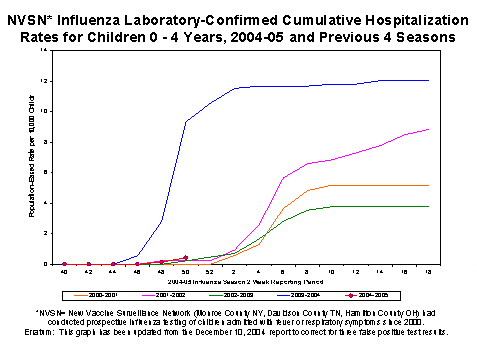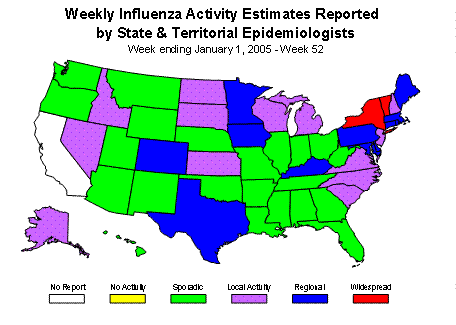Error processing SSI file
Error processing SSI file
Weekly Report: Influenza Summary Update
Week ending January 1, 2005 -- Week 52
Error processing SSI fileThe following information may be quoted:
Synopsis:
During week 52 (December 26, 2004-January 1, 2005)*, influenza activity continued to increase mostly in the eastern United States. Three hundred nineteen (12.1%) specimens tested by U.S. World Health Organization (WHO) and National Respiratory and Enteric Virus Surveillance System (NREVSS) collaborating laboratories were positive for influenza viruses. Fifty percent of all isolates this season have been reported from the Mid-Atlantic and New England surveillance regions**. The proportion of patient visits to sentinel providers for influenza-like illness (ILI) is above the national baseline. The proportion of deaths attributed to pneumonia and influenza is below the national baseline. New York, Vermont, and New York City reported widespread influenza activity, 12 states reported regional influenza activity, and 13 states and the District of Columbia reported local activity. Twenty-two states reported sporadic influenza activity and 1 state did not report.
Laboratory Surveillance*:
During week 52, WHO and NREVSS laboratories in the United States reported testing 2,634 specimens for influenza viruses, of which 319 (12.1%) were positive. Of these 56 were influenza A (H3N2) viruses, 237 were influenza A viruses that were not subtyped, and 26 were influenza B viruses.
Since October 3, WHO and NREVSS laboratories in the United States have tested a total of 34,497 specimens for influenza viruses and 1,369 (4.0%) were positive. Among the 1,369 influenza viruses, 1,128 (82.4%) were influenza A viruses and 241 (17.6%) were influenza B viruses. Four hundred six (36.0%) of the 1,128 influenza A viruses have been subtyped; 404 (99.5%) were influenza A (H3N2) and 2 (0.5%) were influenza A (H1N1) viruses. Three hundred sixty-two (26.4%) of the 1,128 isolates have been reported by the Mid-Atlantic region** and 316 (23.1%) were from the New England region.
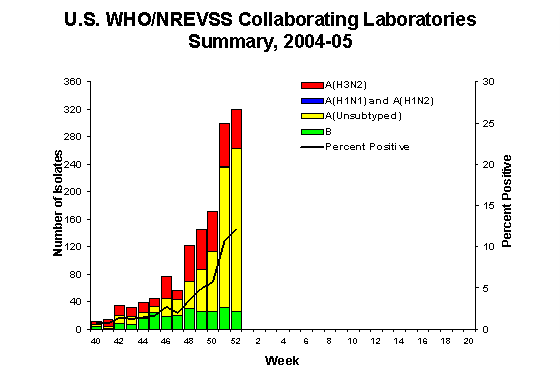
Antigenic Characterization:
CDC has antigenically characterized 107 influenza viruses collected by U.S. laboratories since October 1, 2004: eighty-five influenza A (H3N2) viruses and 22 influenza B viruses. All of the influenza A (H3N2) isolates were characterized as A/Fujian/411/2002-like (H3N2), which is the influenza A (H3N2) component recommended for the 2004-05 influenza vaccine.
Influenza B viruses currently circulating can be divided into two antigenically and genetically distinct lineages represented by B/Yamagata/16/88 and B/Victoria/2/87 viruses. B/Yamagata lineage viruses circulated widely between 1990 and 2001 during which time B/Victoria-like viruses were not identified outside of Asia. However, between March 2001 and October 2003, B/Victoria-like viruses predominated in many countries, including the United States and the vaccine strains were changed accordingly. While both Victoria lineage and Yamagata lineage viruses have been reported worldwide during the past year, Yamagata lineage viruses have once again become predominant. Nineteen of the influenza B viruses isolated this season belong to the B/Yamagata lineage and were characterized as B/Shanghai/361/2002-like, which is the influenza B component recommended for the 2004-05 influenza vaccine. Three influenza B viruses belong to the B/Victoria lineage and were characterized as B/Hong Kong/330/2001-like.
Pneumonia and Influenza (P&I) Mortality Surveillance*:
During week 52, 6.7% of all deaths reported by the vital statistics offices of 122 U.S. cities were attributed to pneumonia or influenza. This percentage is below the epidemic threshold of 7.9% for week 52.
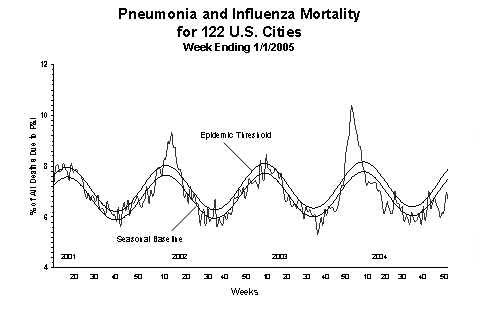
Influenza-Associated Pediatric Mortality*:
As of week 52, no pediatric deaths associated with laboratory-confirmed influenza have been reported to CDC.
Influenza-Associated Pediatric Hospitalizations:
The New Vaccine Surveillance Network consists of three sites in Cincinnati OH, Nashville TN, and Rochester NY. The sites conduct population-based surveillance for laboratory-confirmed influenza among children 0-4 years of age who are admitted to the hospital with fever or acute respiratory illnesses. During October 3-December 25, 2004, the preliminary influenza-associated hospitalization rate for children 0-4 years old was 0.42 per 10,000 children based on 2 laboratory-confirmed hospitalizations. Three hospitalizations previously reported as being associated with influenza have since been reclassified as non-influenza hospitalizations after laboratory results were shown to be false-positives. Hospitalization rate estimates are preliminary and may change as data continue to be collected. In years 2000-2003, the end-of-season hospitalization rate ranged from 3.7 to 12 per 10,000 children.
The Emerging Infections Program (EIP) is collecting data in 10 sites on hospitalizations of children <18 years of age with illnesses associated with laboratory-confirmed influenza. Hospitalization data from the EIP sites will be included as they become available.
Influenza-like Illness Surveillance*:
During week 52, 3.0%*** of patient visits to U.S. sentinel providers were due to ILI. This percentage is above the national baseline of 2.5%. The percentage of visits for ILI ranged from 1.5% in the West North Central region** to 5.1% in the Pacific region. Due to wide variability in regional level data, it is not appropriate to apply the national baseline to regional level data.
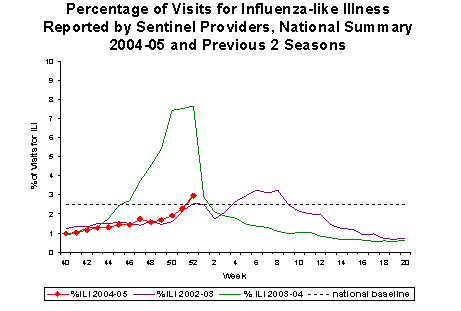
View
Chart Data
| View Full Screen
Influenza Activity as Assessed by State and Territorial Epidemiologists*:
During week 52, New York State, Vermont, and New York City reported widespread activity. Twelve states (Connecticut, Colorado, Delaware, Iowa, Kentucky, Maine, Maryland, Massachusetts, Minnesota, Pennsylvania, Rhode Island, and Texas) reported regional influenza activity. Thirteen states (Alaska, Idaho, Kansas, Michigan, Nevada, New Hampshire, New Jersey, North Carolina, North Dakota, South Carolina, South Dakota, Virginia, and Wisconsin) and the District of Columbia reported local activity. Twenty-two states (Alabama, Arizona, Arkansas, Florida, Georgia, Hawaii, Illinois, Indiana, Louisiana, Mississippi, Missouri, Montana, Nebraska, New Mexico, Ohio, Oklahoma, Oregon, Tennessee, Utah, Washington, West Virginia, and Wyoming) reported sporadic influenza activity. California did not report.
--------------------------------------------------------------------------------
* Reporting is incomplete for this week. Numbers may change as more reports are received.
** Surveillance Regions: New England (Connecticut, Maine, Massachusetts, New Hampshire, Vermont, Rhode Island); Mid-Atlantic (New Jersey, New York City, Pennsylvania, Upstate New York); East North Central (Illinois, Indiana, Michigan, Ohio, Wisconsin); West North Central (Iowa, Kansas, Minnesota, Missouri, Nebraska, North Dakota, South Dakota); South Atlantic (Delaware, Florida, Georgia, Maryland, North Carolina, South Carolina, Virginia, Washington, D.C., West Virginia); East South Central (Alabama, Kentucky, Mississippi, Tennessee); West South Central (Arkansas, Louisiana, Oklahoma, Texas); Mountain (Arizona, Colorado, Idaho, Montana, Nevada, New Mexico, Utah, Wyoming); Pacific (Alaska, California, Hawaii, Oregon, Washington)
*** The national and regional percentage of patient visits for ILI is weighted on the basis of state population.
Report prepared: January 6, 2005
Error processing SSI file